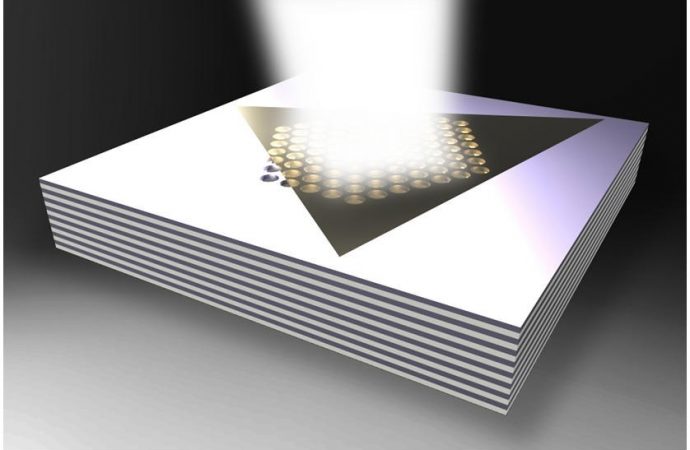Researchers have developed a method for achieving an order-of-magnitude enhancement of the light emission from a class of two-dimensional (2D) materials called transition metal dichalcogenides (TMDs).
The large light enhancement arises when the 2D material is placed on a photonic hypercrystal, which is an artificial optical material first proposed in 2014 by Evgenii E. Narimanov at Purdue University, who is one of the authors of the new study.
The research team is led by Vinod M. Menon, a physics professor at the City College of the City University of New York (CUNY), and Yi-Hsien Lee, a professor of materials science and engineering at National Tsing-Hua University in Hsinchu, Taiwan. Their work is published in a recent issue of Nano Letters.
In recent years, 2D materials such as 2D TMDs have attracted a great deal of attention because their atomic-scale thickness leads to exceptional electronic and optical properties, making them potential candidates for future optoelectronic devices.
2D TMDs are particularly appealing because they spontaneously emit light due to their direct band gaps, which enables electrons to directly emit photons. Currently, however, 2D TMDs don’t produce enough light to make them useful as practical light-emitting devices.
In the new study, the researchers have shown that photonic hypercrystal substrates can transform low-light-emitting TMDs into much brighter sources of light.
The researchers designed a photonic hypercrystal by patterning a periodic lattice of holes, each about 100 nanometers in diameter, in a hyperbolic metamaterial. When 2D TMDs, such as WS2 or MoS2 flakes, are placed on top of the photonic hypercrystal, the light emitted by the TMDs is enhanced due to the large number of photonic states inside the hypercrystal.
For the WS2 flakes, this coupling makes the overall light intensity 56 times greater than it is on a reference substrate, and seven times greater than it is on a hyperbolic metamaterial alone (without the holes). The design also concentrates the emission so that it can be focused in a specific direction.
“We were able to enhance the light emission from a 2D material by close to two orders of magnitude over the entire emission spectrum,” Menon told Phys.org.
The researchers attribute this large light enhancement and concentration to the unique properties of photonic hypercrystals, which combine the optical properties of both photonic crystals and hyperbolic metamaterials.
Photonic crystals are composed of periodic layers that allow certain wavelengths of light to pass through while prohibiting others. In the design presented here, the periodic lattice of holes serves as the photonic crystal, and the period is optimized to allow high-momentum light to pass through.
On the other hand, hyperbolic metamaterials get their name from the hyperboloid shape of the dispersion in the metamaterial. Typical optical materials have closed dispersions that are either spherical or elliptical in shape, which limits the maximum momentum that the photon can have.
By combining the properties of both materials, photonic hypercrystals are strong light emitters like hyperbolic metamaterials, but the light is also modulated and controllably scattered as in photonic crystals. This combination allows for the unprecedented degree of control and enhancement of light propagation that the researchers achieved here.
The researchers expect that, in the future, this approach can be used to develop practical optoelectronic devices made of 2D TMD materials. Their next step will be to develop an electrically pumped light-emitting device based on 2D TMDs.
Source: Phys.org


































Leave a Comment
You must be logged in to post a comment.